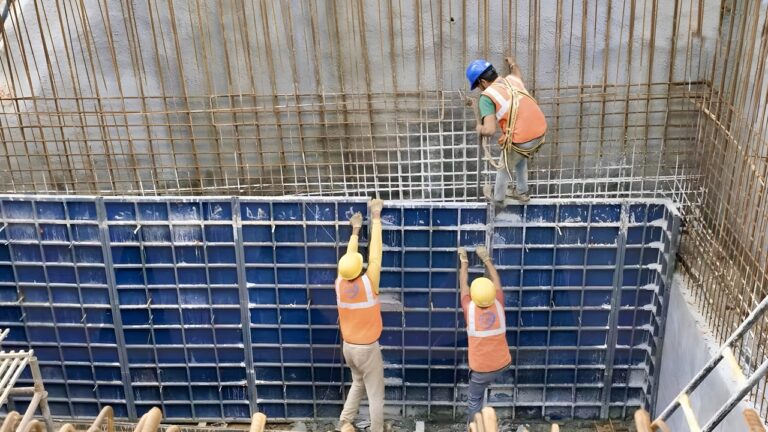Selecting the right thickness for shuttering sheets is critical before starting any structural construction involving concrete. Not only does it determine the load capacity, but it also impacts the safety, cost-efficiency, and longevity of your project. The main factor in picking the right thickness is the load capacity. Simply put, the thicker the sheet, the higher its load capacity, making it essential to select the right thickness for the specific demands of your project.
Choosing the correct plastic sheet is easy if you know the right thickness for shuttering plywood. Although plastic shuttering sheets and shuttering plywood share similar use cases, plastic sheets have the upper hand due to their versatility, durability, and eco-friendly properties.
Many thickness options are available in the market, ranging from 4 mm to 21 mm and beyond, but let’s look at the most commonly used ones in the industry: 8mm, 12mm, and 16mm shuttering boards.
Understanding Plastic Sheets in Construction
Plastic sheets are widely used in construction for applications such as formwork, insulation, protective barriers, and more. Their resistance to moisture, water, chemicals, and wear makes them ideal for a variety of construction requirements. The fact that plastic shuttering sheets can be endlessly recycled eback into shuttering sheets makes them a perfect choice, unlike shuttering plywood, which uses virgin material and ends up in landfills or dump yards—contributing to sustainable alternatives in the construction industry.
Selecting the Right Thickness
The thickness of plastic sheets is a crucial factor in determining their suitability for different applications. Here’s a quick guide to help you choose the right thickness for your project:
8mm Plastic Shuttering Sheets
8mm plastic sheets are rigid and strong, handy for light to medium-duty formwork where the loads are not excessively heavy. These sheets offer high-impact resistance and durability, making them ideal for heavy-duty construction work. If the load-bearing capacity is low, they make moulds for structural elements like columns, beams, slabs, and walls. Since they are flexible, sizes between 6 mm-8 mm can be used for circular shuttering as well, but again depending on the diameter of the structure.
Since the thickness is low, and if the load is higher, more runners will be required to avoid undulations.
12mm Plastic Shuttering Sheets
12mm Plastic Shuttering Sheets are the most commonly used thickness variant for formwork applications. They are used for columns, beams, slabs and retaining walls and have a mid to high load-bearing capacity. They are used in residential, commercial and high-rise construction projects.
They are ideal for most applications and can be reused multiple times. They are thicker and more robust than 8mm sheets, offering greater strength and durability. The 12mm thickness provides the necessary strength to withstand the pressure of large volumes of wet concrete. Here are the applications:
1. Slab Formwork:
12mm plastic shuttering sheets are commonly used for slab formwork, mainly when slab thickness is substantial and must support significant weight.
2. Beams and Columns:
They are used to form beams and columns, ensuring a smooth finish and precise dimensions. The thicker sheet helps maintain the shape and alignment of these critical structural elements.
3. Retaining Walls and Shear Walls:
In construction projects involving retaining walls or shear walls, 12mm sheets provide the necessary stability and rigidity to the formwork, ensuring the walls are formed correctly.
16mm Plastic Shuttering Sheets:
16mm shuttering sheets are among the thickest available in the category of formwork. These sheets are designed for the most demanding construction applications, where maximum strength, durability, and load-bearing capacity are required. Here’s an overview of their uses and applications:
1. Heavy-Duty Formwork:
16mm shuttering sheets are primarily used to construct large-scale concrete structures, including massive beams, slabs, columns, and foundations. The thickness provides exceptional support, ensuring the formwork can handle the high pressures exerted by wet concrete.
2. Infrastructure Projects:
These sheets are ideal for infrastructure projects like bridges, dams, flyovers, and tunnels, where the structural components are massive, and the formwork must be extremely sturdy to hold the concrete in place as it cures.
3. Retaining and Shear Walls:
For retaining walls, shear walls, and other load-bearing walls that require substantial support, 16mm shuttering sheets provide the necessary rigidity to ensure the walls are formed correctly and can withstand external forces.
4. Heavy Industrial Applications:
In industrial construction, where large and heavy machinery foundations are needed, 16mm sheets are used to create the formwork, ensuring the concrete structures are robust and long-lasting.
Key Factor: Runners and Support in Formwork
Since plastics are flexible, adding sufficient runners and support to the formwork on plastic shuttering sheets is advised. They will ensure undulations are restricted even when the sheet reaches its end of life.
Runners are the additional support structures placed beneath the formwork to ensure even load distribution and minimise the risk of deformation.
By carefully considering the applications and requirements of your construction project, you can ensure that you select the most suitable plastic sheet thickness.
Conclusion
Plastic sheets are versatile and sustainable options for various construction applications. They are also an environmentally friendly alternative to shuttering plywood. Plastic shuttering sheets provide more repetitions than shuttering plywood, providing a better finish. By understanding the appropriate thickness for your needs, you can ensure the success and durability of your construction project.
WoWMaterials offers a wide range of high-quality plastic shuttering sheets tailored to the diverse needs of modern construction. Ready to make your project more sustainable? Explore our products or reach out to our team for expert guidance today.
Visit our website or contact us for personalised recommendations tailored to your project’s requirements.

